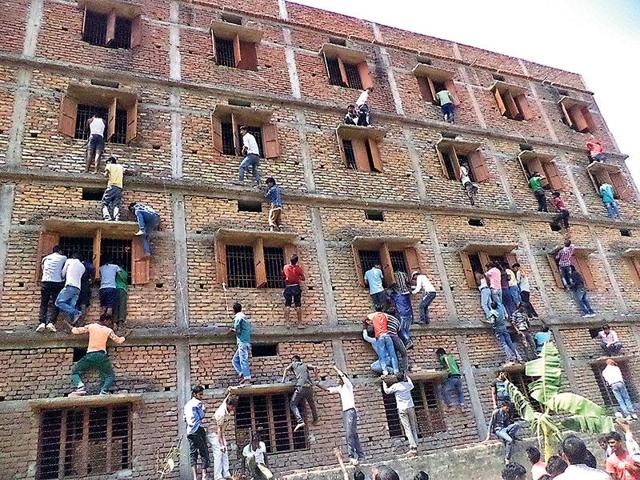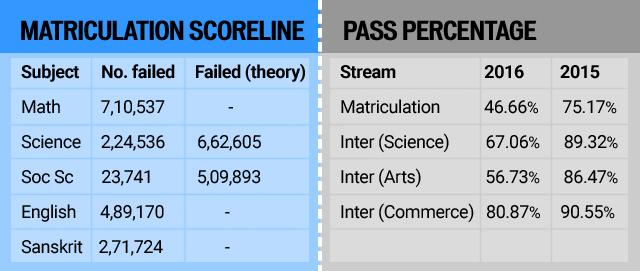Bihar board results send alarm bells ringing
Without multiple-choice, practicals, results could have been worse, experts say teachers, system too have failed.
Imagine a student unable to get even pass marks in science, but securing over 90% in practicals! Or a student hitting bull’s eye in multiple-choice segment and fumbling in the theory paper of the same subject!

There is nothing surprising about such scenarios in Bihar, as a TV channel tried to expose when he asked an intermediate topper in arts about what she studied in political science. The reply was: “We learn about cooking.”
Another topper in science could not even answer a basic question from periodic table.
With the year 2016 witnessing a steep fall in the results of matriculation and intermediate, the authorities have been quick to attribute it to tight conduct of exams after a year of ignominy in 2015, when scenes of students climbing up the wall for cheating went viral.
But there is more to the results than just tight conduct. The results would have got even worse had there been no multiple-choice segment and practicals in intermediate and practicals in matriculation.
“The examination has not just failed the students, it has also failed the teachers and exposed the education system. How can the students study in schools if there are no teachers? First requirement is teaching and then comes examination,” said former Bihar board chairman AKP Yadav.
Read more: Stung by video on topper, Bihar board orders probe into exam results
The statistics say it all, with more than half (53.4%) of the students failing in matriculation, a steep fall from 75.17% just a year ago. In mathematics, out of 15,47,083 students, 7,10,537 failed, while in science the number of those failing was just 2,24,536.
A detailed investigation found that in science, 6,62,605 students had failed to get even 30 marks out of 80, but in practicals most of them scored between 16-19 out of 20. Even in social science, 5,09,893 students failed in theory, but with the help of practical paper the number dropped to just 2,83,756.
An even starker trend was evident in intermediate science, in which the pass percentage fell from 89.32% to 67.06% and the number of students securing first division fell more sharply from 49.17%. to 21.77%.
“It is a fact that objective-type tests make it easier for students and they manage to make up for deficiency in theory. Invariably, it has been seen that the students fare better in multiple-choice tests. In practicals also, schools are generally liberal in marking,” said Bihar board ecretary Hariharnath Jha, admitting that the pass percentage could have dipped further had been there no objective-type segment.
Read more: More than 50 percent fail in Bihar’s class 10 exams
Former chairman Rajmani Prasad Sinha said the results had mirrored the ground reality of education and it was high time the government heeded the alarm bells. “What has happened is the outcome. First the problem of teaching would have to be solved so that the students go to school and the syllabus is properly covered. Otherwise, only the students will suffer. We should not expect results without teaching,” he added.
Teachers’ shortage in key subjects
In Bihar, there is acute dearth of secondary and higher secondary teachers, especially in key subjects. In the state teachers’ eligibility test (STET) conducted in 2011, just three trained and five untrained teachers could qualify in physics, which is taught in class 9-12. In Chemistry, math, botany, English and other subjects, the pass percentage of trained teachers was just a small fraction, not enough for even five percent of around 6900 schools.
Though there are around 40,000 teachers in secondary and higher secondary, including those working on old prescribed pay-scale, the problem is acute in core science subjects and English. Despite four phases of recruitment, against 12,366 vacancies in secondary and 17,550 in higher secondary, the government could find just 6,631 and 5,423 teachers respectively so far, with important subjects having virtually negligible numbers.
“In mathematics, against 1,776 vacancies in secondary schools only 880 could be filled, while in English against 2,295 vacancies the number was just 300,” said an education department official.
In higher secondary, the problem is worse, even though the government has been consistently upgrading secondary schools to cater to the growing needs. In chemistry, against 1,698 vacancies, there only 12 could qualify, while in Physics the number was just three. In Botany, against 533 vacancies, there are just 33 teachers.
Faced with a big challenge of finding quality teachers, the government is now mulling the option of organizing a special TET for subjects, which have huge shortfall of teachers. But the officials are still unsure if they would be able to get quality teachers, as teaching in secondary and higher secondary levels is a challenge.
Education minister Ashok Choudhary said the government would soon work out a schedule for special TET for key subjects having big shortfall of teachers. “The government schools in 1960s to 1980s were known for imparting quality education. We want to bring back old days,” he added.

Ministerspeak
Education minister Ashok Choudhary said that tight examination was the basic requirement and the government had succeeded in ensuring it. “Now, the students and teachers would also know that there is no shortcut available. The teachers will have to teach and the students should on study. As far as shortage of teachers is concerned, we are concerned about it. Due to panchayat polls, the process got a bit delayed, but now we go in for it immediately,” he added.











